31 - 41 of 41 records
France revised and augmented
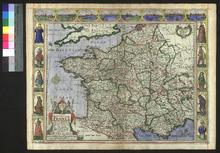
Description: Appeared in Speed's Prospect of the Most Famous Parts of the World (first published in 1627),On verso: Text: The Description of France
Member of: Venable Maps
Resource Type: cartographic
A New Chart of the English Channel, drawn from the Best Authorities. / A New Chart of the Coasts of France and Spain from L'Orient to Gibraltar, Drawn from the Best Authorities

Member of: Venable Maps
Resource Type: cartographic
A New and Correct Map of France
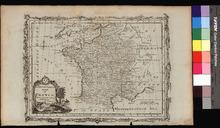
Description: Appeared in Moore's A new and complete collection of voyages and travels (1778).,On verso: Blank
Member of: Venable Maps
Resource Type: cartographic
Map of Central Europe
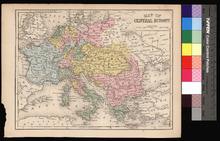
Description: Appeared in Mitchell's New Intermediate Geography (published in various editions between 1869 and 1901). Different editions were produced for different states.,On verso: Text: Great Britain and Ireland (Wales, Ireland)
Member of: Venable Maps
Resource Type: cartographic
Bible. Latin. O. T. Isaiah. [leaf]
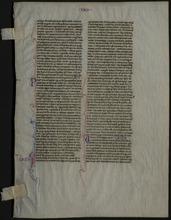
Description: 12mo (17 x 12.3 cm, 6.75 x 4.875"). [1] f.A "Peaceable Kingdom" leaf from a small Bible: Paris was the center of Bible production in the 13th century, with the text having been standardized there, and the University attracting scholars who wished to have just such a small Bible as this leaf came from—a new thing in the 13th century. The text here is Isaiah 61:3-66:10, containing a prophecy of the restoration of Jerusalem, including the well-known Isaiah 65:25: "The wolf and the lamb shall feed together, and the lion shall eat straw like the bullock: and dust shall be the serpents meat. They shall not hurt or destroy in all my holy mountain, saith the Lord."(KJV)nnThis leaf is of very fine paper-thin vellum. The text is in two columns per page of 53 lines, faintly ruled in lead, the top line written below the top rule; it is written in black ink in an extremely small and compact Gothic script of the style typical of Bibles and other scholarly manuscripts of the 13th century. The running headers are in red and blue ink, the numbers heading each chapter are likewise in red and blue, and the 5 two-to-three-line initials (3 on the recto, and 2 on the verso) beginning each chapter are in red or blue, the Q's with long descenders, and all with elaborate long tracery in the contrasting color. A few instructions to the rubricator are to be found in the gutters.nnParchment with slight cockling. Some letters rubbed, affecting legibility in one place. Two pieces of cloth tape, likely for mounting, have been attached in the inner margin of the verso, running beyond the edge of the leaf. The quality and thinness of the parchment, the minuteness of the writing, and quality of the decoration make this a particularly fine, beautiful, and delicate piece.,Full pdf available, https://dl.mospace.umsystem.edu/mu/islandora/object/mu%3A439258/datastream/PDF/view
Member of: Private Collection of Antiquarian Books and Manuscripts
Resource Type: Text
Bible. Latin. N. T. Mark. [leaves]

Description: (Mark, chapts. 9-10, including the Transfiguration)nn"ILLUMINATED VELLUM MANUSCRIPT LEAVES FROM A PORTABLE BIBLE IN LATIN. (France, ca. 1250) 5 3/4 x 3 3/4". Double column, 49 lines, written in a tiny gothic book hand. Each leaf featuring capitals struck with red, headlines and verse numbers in blue and red, and one-line versal initials in red or blue. Many leaves with larger (typically four-line) initials in blue or red with elaborate penwork infilling and marginal extension in the same and contrasting colors. SOME LEAVES WITH LARGER INITIALS (typically seven- and nine-lines high) IN DIVIDED RED AND BLUE, OFTEN WITH VERY LONG MARGINAL EXTENSION, sometimes the entire length of the leaf. Most leaves with at least some (and a few leaves with many) MARGINAL ANNOTATIONS IN AN INCREDIBLY TINY HAND. Leaves variably dampstained diagonally across upper portion (sometimes as little as a tenth of the leaf affected, sometimes as much as a third, the discoloration never really absent, but never really dark), vellum a bit cockled, but pleasing leaves nevertheless, the text still quite distinct, the vellum generally clean, and the margins especially ample. Available are a number of leaves from a sizable fragment of a so-called pocket Bible, a 13th century innovation that is discussed in item #9, above. Of special interest here are the annotations: while the script of our leaves is quite tiny (though no smaller than many other 13th century portable Bibles), the annotations here are half(!) the size of the text, a fact that is almost as astonishing as the fact that these marginal notes are beautifully written and perfectly legible (though requiring for most eyes the assistance of magnification). Provided with each leaf offered here is an English translation of the text present on both sides of the leaf. While no English printed version is equivalent to the Latin Vulgate text used here, we have chosen one that comes close, using the 1582 Rheims New Testament and a 1635 printing of the Douay Old Testament.",Full pdf available, https://dl.mospace.umsystem.edu/mu/islandora/object/mu%3A439247/datastream/PDF/view
Member of: Private Collection of Antiquarian Books and Manuscripts
Resource Type: Text
Bible. Latin. O. T. Ezekiel [bifolium]

Description: "Bifolium. Manuscript on vellum, 12mo (17.7 x 23.7 cm, 7 x 9.25"). [2] fA double-page spread from a small Paris Bible. Paris was the center of Bible production in the 13th century, with the text having been standardized there, and the University attracting scholars who wished to have just such a small Bible as this double leaf came from—a new thing in the 13th century. The texts on this bifolium are Ezekiel 27:11-30:3, containing prophecies against Tyre and Egypt, and Ezekiel 44:17-47:4, with directions for restoring the life of a just and righteous Israel and the beginning of Ezekiel's vision of water pouring forth from the temple.nnThis leaf is of very fine paper-thin vellum. The text is in two columns per page of 53 lines, faintly ruled in lead, the top line written above the top rule. The outer edge of the second leaf retains its prickings. Text is written in black ink in a very small and compact Gothic script of the style typical of Bibles and other scholarly manuscripts of the 13th century. The running headers are in red and blue ink, the numbers heading each chapter are likewise in red and blue, and there are 1 ten-line initial I (in red with blue tracery), 1 four-line initial H (in blue with red tracery), and 4 two-line initials (in red or blue with tracery in the contrasting color). Key initials in the text are lined in red. Some corrections have likewise been made in the text, in black or red, and there is some marginalia in black and red in an early hand.",Full pdf available, https://dl.mospace.umsystem.edu/mu/islandora/object/mu%3A439250/datastream/PDF/view
Member of: Private Collection of Antiquarian Books and Manuscripts
Resource Type: Text
Bible. Latin. O. T. I Samuel. [leaf]
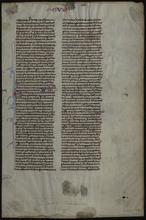
Description: 12mo (19.6 x 13.1 cm, 7.75 x 5.125"). [1] f.Paris was the center of Bible production in the 13th century, with the text having been standardized there, and the University attracting scholars who wished to have just such a small Bible as this leaf came from—a new thing in the 13th century. [BEING QUERIED: The text here is I Samuel 22:15-25:8, including the pursuit of David by King Saul and the famous scene where David sneaks up and cuts off part of the king's cloak, later showing it to Saul as proof of his good faith, that when he could have killed him, he forebore doing so.]nnThis leaf is of fine quality (i.e., thin) vellum, with the text in two columns per page of 57 lines each, ruled in lead, the top line written below the top rule. The pricking for the rules is still present on the outside edge of the leaf. The scribe has written very small in black ink in compact Gothic script of the style typical of Bibles and other scholarly manuscripts of the 13th century, though it shows a few characteristics of later cursive Gothic. The running headers are in red and blue letters with a little pen tracery. The numbers heading each chapter (XXIII, XXIIII, and XXV) are likewise in red and blue, and there are 3 two-line initials (one on the recto and two on the verso) heading each chapter, a red E, a blue A (with a long descender), and a red M, each with elaborate and long tracery in the contrasting color. There are also notes to the rubricator on the edges.nnProvenance: Ex-Zion Research Foundation (later known as the Endowment for Biblical Research); very likely to Zion from Ege. nnSome spots of staining in the margins, and remnants of adhesive with vellum thinned where it was removed.,Full pdf available, https://dl.mospace.umsystem.edu/mu/islandora/object/mu%3A439261/datastream/PDF/view
Member of: Private Collection of Antiquarian Books and Manuscripts
Resource Type: Text
Bifolium from a Book of Hours
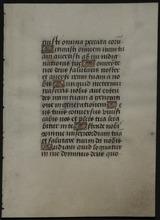
Description: Manuscript vellum bifolium (two leaves) from a book of hours. The text includes parts of the Gospel readings and some prayers. Folio 2r begins with Psalm 116:1: "Laudate Dominum omnes gentes; laudate eum omnes populi." France, late 15th or early 16th century. Batarde hand. Text in one column of 17 lines. One and two-line illuminated initials, in gold, red, violet and white. 12.7 x 9 cm. Catalogued by PRB&M (short description included with the item).
Member of: Private Collection of Antiquarian Books and Manuscripts
Resource Type: Text
Catholic Church Liturgy (fragment)
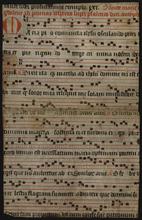
Description: A partial leaf from a liturgical manuscript on vellum, probably a church service book. The text on the recto is in a single column of 12 lines with ten 4-line staves, rule din red with neumes in black, and on the verso in a single column of 33 lines (no staves) ruled in red. The recto has text and chant of prayers for celebration of the Feast of [Saint] Mary Magdalene (22 July): the rubric reading "Sancte marie ma/gdalene ad primas vesperas super salmos diei. antyphon," (lines 1-2) and the text beginning: "Maria pio coniuncta ihesu osculando pedes..." (line 3). The verso contains a list of prayers (maunly collects?) for celebrating feasts of a number of saints and occasions, including the feasts of Saint Peter and Saint Paul. The text is written in a Gothic textura book hand of good quality in two grades of formality: the text on the recto and that of larger size on the verso is written in the slightly less formal textualis semi-quadrata. There is frequent use of abbreviations including both contractions and suspensions. The music for the chant is written in neumes. The recto has a single larde initial "M" in red (the height of one stave plus one line) marking the opening of the chant for "Maria pio communita oscilando..." and on the verso are six large 2-line initials in alternating red and blue. This leaf was used as binding waste in making up a volume half its size, to which end it was heavily cut down to a size just smaller that the text block and rotated horizontally. A crease running horizontally accross the middle of the leaf shows the mark of the spine of the volume. (description provided by seller)
Member of: Private Collection of Antiquarian Books and Manuscripts
Resource Type: Text
Commentary on Peter Lombard's Sentences, with the Abridgement of the Sentences.
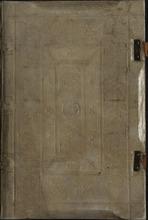
Description: 148 leaves (including fly), complete, collation: i- xv10, xvi7 (first leaf a singleton added to complete text, but text continuous – compare the online photographs of Yale, Beinecke MS. 1079, fols. 196r-197v; this gathering includes three endleaves and the rear pastedown), contemporary catchwords and modern pencil pagination on lower corners of rectos, Latin text in double columns of 18 lines (main text generously spaced) with commentary in smaller script set within blocks filling entire sections of columns or smaller rectangular part (see below), rubrics in dark red-burgundy, paragraph marks in red, running titles in same at head of each page, small initials in red or blue (some with purple or red contrasting penwork). Four illuminated initials in blue, green or dark pink acanthus leaf fronds, enclosing other foliage on burnished gold grounds, single hairline foliage and acanthus leaf sprays in margin, terminating in gold bezants and ivy-leaves and long pointed fruit, encased in penstrokes giving them a distinctive 'hairy' appearance (similar to borderwork on early fifteenth-century Books of Hours and liturgical books, compare L.M.C. Randall, Medieval and Renaissance Manuscripts in the Walters Art Gallery, II: France, 1420-1540, 1992, figs. 197, 199, 201 and 203, all Parisian or northern French first half of fifteenth century). Many marginal and interlinear additions by main hand, a little flaking to opening initial, one or two leaves with small splashes, a few small marginal wormholes, good margins, generally excellent condition. In sixteenth-century blindstamped pigskin boards bevelled in their mid-sections in German style, and tooling of panels of Tudor rose style flower heads and small flowers, binding skilfully restored, traces of metal clasps at fore-edge. Overall, a high quality and elegantly produced ms in excellent and crisp condition.nn"A very fine copy of a fundamentally important medieval text, yet to be edited or extensively studied; and most probably the sole copy to appear on the open market since records began.nnProvenance:nn1. Written and illuminated, most probably for a monastery or cathedral school in eastern France, in the fifteenth century. Bound or rebound with bevelled boards in the German fashion, in the sixteenth century.nn2. In French-speaking ownership in the nineteenth century, with notes on the date of the codex and its contents on front pastedown and front flyleaf.nn3. Alexis Noisilier of Paris: his 1929 printed bookplate to front pastedown.nnPeter Lombard's Sentences was a fundamental compilation that provided the medieval Church with a comprehensive framework for theological and philosophical discussion. It ranks among the most important works of the Middle Ages, and among the handful of commentaries that the thirteenth century produced, that of Hugh of Saint Cher (d. 1263), a French Dominican friar, holds a commanding position. It steered and guided study of Lombard's work for several generations, making itself felt in the works of John of Treviso, the anonymous abbreviation Filia Magistri, the commentary of Richard Fishacre, among others, and most probably contributed to the development of a new type of commentary (see M. Bieniak, 'The Sentences Commentary of Hugh of St.-Cher', in Mediaeval Commentaries on the Sentences of Peter Lombard, 2009, ed. P.W. Rosemann). It is particularly surprising that there is no edition of the text, and only two partial studies of its manuscript tradition – focussing only on the thirteenth-century witnesses (T. Kaeppeli, Scriptores Ordinis Praedicatorum Medii Aevi, 1975, II, p. 272, no. 1983, and IV, p. 125; updated by B. Faes de Mottoni, 'Les manuscrits du commentaire des Sentences d'Hugues de St. Cher', in Hugues de Saint-Cher († 1263) bibliste et theologien, ed. L.-J. Bataillon et al., 2004, pp. 273-98, listing 41 manuscript commentaries – all in European institutions; save a thirteenth-century Spanish at Yale, Beinecke MS. 1079).nnA contemporary hand has added at the end the erroneous note that it was "Abbreviatus ut credunt per M[agister] Alexander de halis", linking its authorship to the English Franciscan writer, Alexander de Hales (d. 1245), which might provide for future scholarship. Faes de Mottoni notes the glosses of this English Franciscan are found alongside those of Hugh of Saint Cher in the crucial early witness of the text in Stockholm, Kungliga Bibliotheket, MS. A 150, a thirteenth-century Parisian witness, which gives all four books of the Sentences in their full form, with the commentary in the margins, and has been identified as an authorial related copy of the work by F. Stegmüller ('Die älteste Redaktion des Senten zenkommentars Hugos von St. Cher in einer Handschrift der königlichen Bibliothek zu Stockholm', Nordisk Tidskrift för Bok- och Biblioteksväsen, 35 (1948), p. 69-79; and the same author's 'Die endgültige Redaktion des Sentenzenkommentars Hugos von St. Cher', Classica et mediaevalia, 9 (1948), pp. 246-265) see also W. H. Principe, 'Hugh of Saint-Cher's Stockholm 'Gloss on the Sentences': An Abridgment rather than a First Redaction', Mediaeval Studies, 25 (1963), pp. 372-376, and J. Gründel, 'Hugo von St. Cher O.P. und die älteste Fassung seines Sentenzenkommentars', Scholastik, 39 (1964), pp. 392-401, for opposing views. If comparison of the commentaries in the Stockholm manuscript and the present links them textually, our copy would be particularly important for knowledge of the history and use of the text in later medieval France.nnThis is thought to be Hugh of Saint Cher's first work, and he is known to have lectured on the Sentences at the University of Paris in 1226-1227, 1229-1230 and perhaps also 1230-1231. It is in fact two texts: a complete abridgement of the entire Sentences (hence the work is sometimes, inaccurately, called an epitome), as well as the commentary itself. Moreover, it is notable that the commentary here is set in smaller script in smaller blocks occupying the whole or sections of the text columns in a way clearly derived from the arrangement of glossed books of the Bible by Parisian book-producers in the twelfth and thirteenth centuries (see C. de Hamel, Glossed Books of the Bible and the Origins of the Paris Booktrade, 1984). While such a format is absent from some early witnesses (such as the Stockholm manuscript), it is found in others, such as the Yale copy, which presents the similar text and commentary in a near identical format. Clearly this 'Glossed Bible' format has its origins in the earliest history of the text, and thorough study of the surviving witnesses would probably reveal families and patterns. The present ms stands as an important record of the continuing use of this format into the fifteenth century.nnThe work itself is of breath-taking rarity on the market, with the vast Schoenberg database listing only one possible copy: offered for sale by B. Rosenthal, cat. 1 (1954), no. 5 (although its small size there suggests that it was in fact a copy of the Filia Magistri – as was the text of the same title offered online by Les Enlumineres, their TM 905, in 2019). The Beinecke bought theirs from an undeclared and possibly private source in 1920. Thus, the present copy would appear to be the sole copy of this important text to appear on the market since records began.
Member of: Private Collection of Antiquarian Books and Manuscripts
Resource Type: Text
Pagination
- Previous page
- Page 3